What Do Moles Eat? (They have a super weird diet…)
Their snouts are extended and hairless, their eyes seem to be nonexistent, and their “paws” look more like flaps than external appendages.
Because of their bizarre physical features, one is inclined to wonder what (and how) moles eat in the wild.
Whether you’re just curious about what these mysterious creatures eat or you’re trying to solve a problem-causing mole, we’ve got you covered.
Ed has been working in the pest control industry for years helping 1,000’s of homeowners navigate the world of insect and rodent management. He manages Pest Strategies now helping homeowners around the world!
Table of Contents
The Average Mole Diet
While classified as mammals, moles are actually not carnivores, herbivores, or omnivores.
They fall into the sub-category of insectivores, and they actually benefit you in your yard upkeep.
What Is An Insectivore?
This is an animal that eats only insects. Technically, this is a subset of the carnivorous diet pattern, but it is its own smaller, distinguished category due to the fact that insectivores only eat the “meat” of insects.
Moles have a few different favorite foods, all found in the soils where the mole spends the vast majority of its 3-year lifespan:
- Earthworms
- Centipedes/millipedes
- Insect larvae
Related Articles
A Mole’s Favorite Food: Earthworms
Everyone who’s ever played out in the dirt as a kid has probably come into contact with at least one earthworm at some point. They’re distinctive in that they have long, dark-orange or even reddish bodies broken into up to 150 segments.
Earthworms are widely regarded as the ideal meal for a mole. It has been reported that moles will regularly dine on earthworms throughout the day, as well as stash some in their burrows for later.
Earthworms also serve as the mole’s primary form of hydration due to the high content of water within the segments of the worm’s body.
Because moles expend so much energy each day, they’ll need a food source in abundance. The population of earthworms in the soil where moles burrow is ample, meaning the mole never runs out of grubs.
The Crunch of Insects
While earthworms are the clear favorite food, moles also like to snack on invertebrates in the dirt. This can include (but isn’t limited to):
- Grubs
- Millipedes
- Centipedes
- Insect larvae
- Crickets
- Slugs
Basically, anything that gets in the mole’s way as it “swims” through the soil can become dinner.
Curious what it looks like for a mole to prey on their food, check out the below video that shows a mole eating worms!
Why Do Moles Eat This Way?
Do you think moles ever get hungry for animal meat?
Probably not. But why?
Well, a mole’s physical traits, actions, and appetite act as variables to explain why this steady diet of insects fulfills and energizes this mysterious animal.
Physical Characteristics of Moles
To take in WHY moles enjoy earthworms and other invertebrates so much, it’s important to know a little bit about their bodies.
So what do moles look like?
The mole’s front feet are more wide than long, and they are stuck to the sides of the mole’s body. This seriously limits a mole’s ability to “catch” prey in the traditional sense.
This is where the importance of having a snout comes in.
The snout of most types of moles is cylindrical and protracted in front of its face. This snout is the perfect size and shape to hold an earthworm in place while consumption can take place.
Think of a mole’s snout like you would an elephant’s: almost like a hand to assist with taking in food.
The outlier in the mole family in terms of using the snout to its advantage is the star-nosed mole–an otherworldly-looking creature with (you guessed it) a star-looking collection of tentacles where a snout would normally be.
These superstars (no pun intended) of the burrows use their alien-like snouts to grip and basically absorb anything edible faster than the human eye can see.
Behavioral Patterns
Moles are not party animals.
In fact, they spend most of the 3 or so years that they’re alive below the ground, mostly living alone in burrows they dig for themselves. If they DO reach the surface of the dirt, it’s either mating season or purely accidental.
Worms, slugs, larvae and other invertebrates are plentiful in the dirt where the mole spends nearly its entire lifespan.
This food supply is delivered right into the mole’s mouth via its snout with minimal effort and almost no resistance, which contributes heavily to its dietary patterns.
Voracious Appetite
Did you know that moles eat almost their entire body weight each day?
Moles, while extremely antisocial, are not sedentary animals. They dig the tunnel networks in which they live nearly every waking moment, and can actually burrow up to 100 feet per day if the soil is moist.
All that exercise means that your average mole is going to need to fuel up as often as possible.
All the insects and worms in the soil are perfect for this; a mole can simple chomp on whatever is handy and get the energy it needs to keep digging.
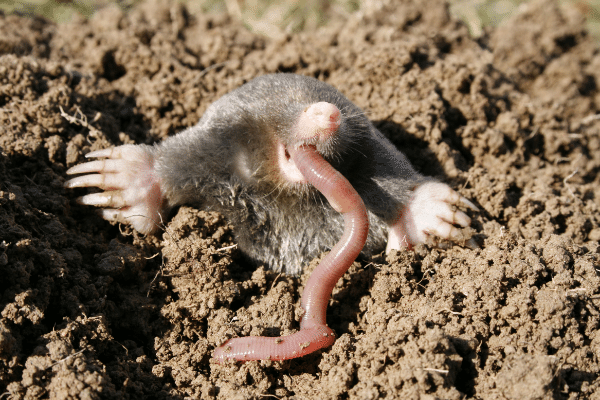
Moles are not party animals.
In fact, they spend most of the 3 or so years that they’re alive below the ground, mostly living alone in burrows they dig for themselves. If they DO reach the surface of the dirt, it’s either mating season or purely accidental.
Find A Local Exterminator
Will Moles Deviate From This Diet?
It’s normal to wonder what would happen if you tried to feed a mole something different.
After all, moles in captivity will eat frogs, mutton, and even cheese with no qualms whatsoever.
If you’re trying to lure a mole out of your yard, should you use some of the popular methods floating around the web?
Let’s take a look at some of the most popular ones.
Will Moles Eat Peanut Butter?
Here’s the thing: a slew of different pests can be lured by peanut butter. It (alongside peppermint oil) is basically the gold standard of vermin control.
The mole? Not so much.
Because this animal has evolved to crave a very specific insectivore diet, its tastes simply don’t include that of nuts or sugar.
Also, its habitat isn’t conducive to a peanut butter bait. Most vermin and rodents can easily sniff out the distinct aroma of peanut butter and run toward a dollop of it because they live out in the open.
Moles, on the other hand, are subterranean, which means they dwell below ground. You can’t exactly shove a dollop of peanut butter in the dirt and expect that a mole will smell it and be attracted to it.
Juicy Fruit Gum Kills Moles, Right?
There’s a ton of internet fodder that you can effectively kill moles in your yard with Juicy Fruit gum.
The myth goes like this: if you cut up strips of Juicy Fruit or a similar off-brand and place the strips within a mole’s tunnel system, the mole will eat it and become constipated, ultimately dying from waste buildup.
This is false as moles are not killed by juicy fruit. This is for a few reasons.
- A mole isn’t attracted to the smell of gum, and would probably treat it like a foreign object. The gum would register as inedible via the nerve endings in their snouts, and the mole would pass it by.
- A human scent in a mole’s tunnel is grounds for the mole to pack up and tunnel somewhere else in the yard. For this reason, the mole would probably never get to the gum.
- If the mole DID ingest the gum, it would be purely accidental. Whether or not the gum would work to constipate and kill the mole is unproven, and should be taken with a grain of salt.
How Do You Kill a Mole With Dish Soap?
Another popular myth floating around the web is that dish soap can effectively kill a mole.
This is inaccurate once again as dish soap does not kill moles. This is for a couple of grounds:
- Many internet searches actually refer to mole crickets instead of moles, which can lead to a lot of confusion.
- The mole crickets actually don’t die because of the dish soap, but they rise to the surface due to the change in the soil with its presence.
HOW THIS CAN WORK FOR MOLES: Theoretically, applying a dish soap and water solution to your soil can make the resident earthworms rise up in the same way that the mole crickets surface.
But cutting off (or drastically reducing) the food source of a mole tunneling through your yard, you can starve it, or at least force it to go burrow somewhere else.
What Do Moles Eat in the Garden?
Does having a mole mean that all your plants will be half-eaten when you look out at your garden every morning?
Keep reading to see how flora is affected by a mole’s incredible appetite.
Destroyed Root Systems
Moles have been said to damage important root families with their constant activity underground.
While it’s commonly assumed that this damage is caused by their incessant snacking, it’s actually the act of burrowing itself that’s causing the damage.
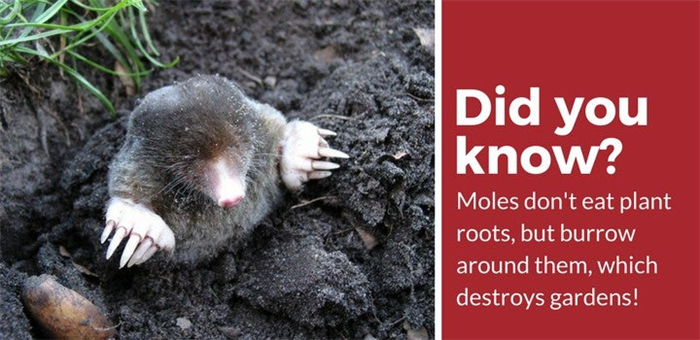
These weakened roots can harm the trees, shrubs, or plants to which they’re attached above the soil, and lead to soft, eroded patches of dirt.
Wiped-Out Grasses
We’ve all heard the expression, “Don’t make a mountain out of a mole hill.”
How’d this phrase come about?
Well, if you’ve ever had a mole on your property, you are fully educated on the signs of moles in the yard. You’ll know all about mounds of dirt pushed up to the surface of the ground, dotting the landscape of your grass in ugly little hills.
In addition to these mole hills, you might see a snaking of dirt like a river system spread out across your grass.
So, do moles eat plants?
Nope. It’s commonly believed that a mole will eat through the grass from above to get to the soil below, but this is actually incorrect. What they’re really doing: tunneling so furiously that the loose soil is excavated and sits along the grass.
The Bottom Line About Moles and Their Diet
Because of their reclusive lifestyle, their nonstop digging, and their unbelievable appetite, it’s common to believe that these guys eat a variety of food items.
Though there’s a ton of speculation to the contrary, moles are some of the pickiest eaters in the mammal kingdom.
Simply put: they really only like worms, larvae, and other invertebrates. If they’re interfering with plants or other food sources, it’s merely accidental.
What Do Moles Eat?
To many people, particularly gardeners, moles are little more than pests. Their conical mounds can easily become a blight on your backyard, leading many people to seek solutions to get rid of them. In reality, moles serve an important ecological function and are a sign of a healthy ecosystem. Moles are small mammals in the family Talpidae commonly found throughout North America, Europe, and Asia. Additionally, there are also non-true moles that live in Australia and parts of Africa. However, these are not the moles that we’re going to be talking about today. Moles are well adapted to the subterranean lifestyle and are prolific tunnel diggers. This causes them to irk gardeners and farmers as their tunnels damage crops and plants. Many people also mistakenly think that they chow down on roots and other plant matter. Which begs the question, “what do moles eat?”
In this article, we’ll attempt to answer all of your questions about the dietary habits of moles. First, we’ll briefly talk about what moles generally like to eat. Then, we’ll move on to a discussion of how moles hunt and forage for food. Next, we’ll compare what moles eat in the wild versus what they eat as pets. Finally, we’ll explore what baby moles eat. So, let’s dig into this topic and answer the question, “what do moles eat?”
What Do Moles Like to Eat?
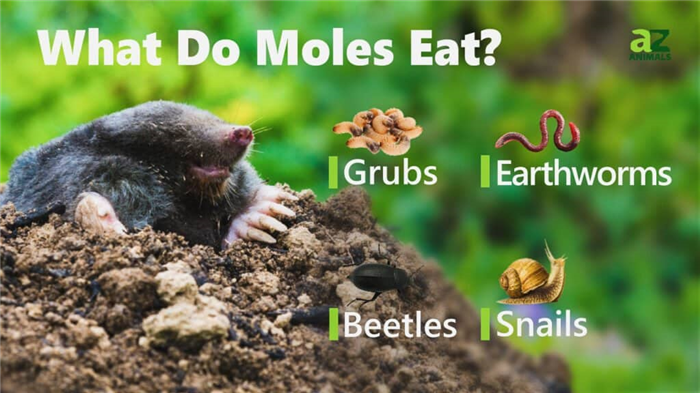
Moles eat a variety of invertebrates including worms, grubs, beetles, and snails.
Moles are subterranean hunters, and spend most of their lives underground. Contrary to popular belief, moles do not eat plants. In reality, they are carnivores that eat massive amounts of animal matter. Specifically, moles tend to target invertebrates and insects, and will do so in large quantities. During the course of a single day, a mole can eat up to 100% of its own body weight in insects. Overall, earthworms are a mole’s favorite food. A single mole will eat tens or hundreds of thousands of worms over the course of its life. That said, moles do not just eat earthworms. They enjoy consuming a wide variety of insects and invertebrates. As such, we’ve compiled a list of 10 foods that moles like to eat. These are the foods that you’ll most commonly find a mole snacking on out in the garden. The 10 foods include:
-
s
- Grubs
- Larvae
- Beetles
- Snails
- Slugs
- Ants
- Spiders
- Millipedes
- Centipedes
- Cicadas
How Do Moles Hunt for Food?
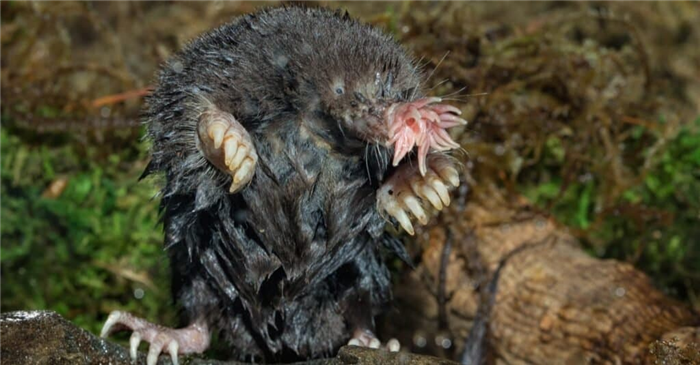
Moles have excellent senses of hearing, smell and touch, but very poor eyesight.
Moles possess many of the same senses as humans, although they use them to different degrees. It’s well known that moles are practically blind, which makes sense given how much time they spend underground. They can only detect light and movement, and can not distinguish color or objects at a distance. As such, they rely on their other senses more to find food. In particular, they have very keen senses of smell, touch, and hearing. A mole uses its hearing to sense vibrations in the soil around it, which is useful for finding burrowing worms. Additionally, research suggests that moles have a stereoscopic sense of smell. Each of its nostrils can operate independently, allowing it to determine the direction of a specific smell. Moles also have very sensitive whiskers, which they use to help them explore their environment.
Moles are most active in the early morning or evening. They prefer to build their homes in moist, loamy soil where their tunnels can maintain their shape. A single mole can dig at a speed of nearly 15 feet per hour. Most tunnels are usually around 2 inches wide and about a foot below the surface. Their dens contain many rooms, including sleeping quarters, a kitchen, birthing areas, and storage rooms. Moles are voracious eaters and tend to immediately consume what they find. In fact, the star-nosed mole is one of the fastest known eaters of any mammal, capable of consuming 10 mouthful-size earthworm chunks in just 2.3 seconds. However, moles also collect uneaten food and store it for later consumption. Some moles have been known to store hundreds of earthworms inside their dens.
What Do Moles Eat in the Wild?
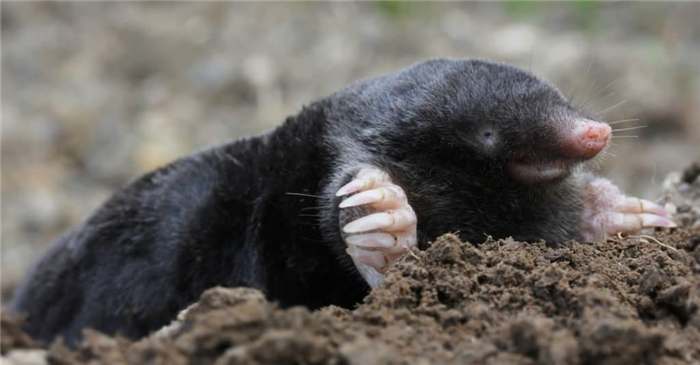
A mole can eat up to 200 worms in a single day.
In the wild, moles will eat pretty much any type of small insect or invertebrate that they can find. They particularly like earthworms, which make up the majority of their diet. A single mole is capable of eating around 50 grams of earthworms in a single day, which equates to around 200 worms. That’s a lot of worms! Since moles have to dig so much, they expend a lot of energy. This may explain why they have such ravenous appetites. Aside from worms, moles also enjoy eating grubs and the larvae of other insects. Moles will also eat other insects and invertebrates that they encounter inside their tunnels. Some common prey that they feast on include snails, slugs, ants, beetles, spiders, centipedes, and millipedes. Moles do not hibernate in the winter, so must hunt all year-round. As such, they will eat whatever unlucky insect that crosses their path.
What Do Pet Moles Eat?
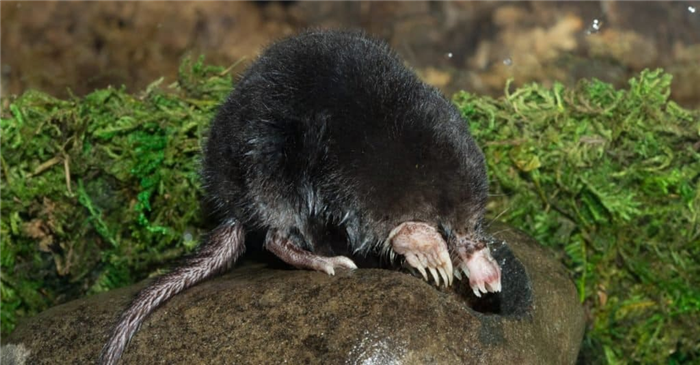
Moles do not make great pets due to their behavior, stress levels, and voracious appetites.
We have to start off by saying that moles do not make great pets. They don’t adapt well to captivity due to their high stress levels and lack of desire for social interaction. Additionally, moles require almost constant feeding in order to stay alive. They eat almost the entire time that they are awake, so feeding a pet mole would be a tall task. However, if you were to keep a captive mole, the main food that it would eat would be earthworms. Lots and lots of earthworms. You’d likely need to feed your pet mole at least 200 worms a day to keep it healthy, if not more. On top of that, you could supplement its diet with other insects such as beetles or grubs. Just remember, you should not keep a mole as a pet under almost any circumstance.
What Do Baby Moles Eat?
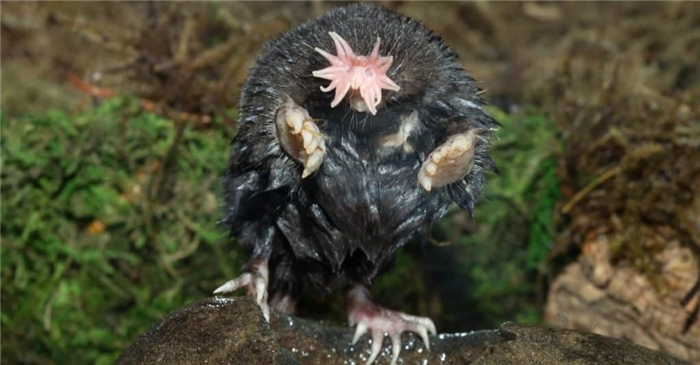
Mole pups rely solely on their mother’s milk for the first month of life.
Mole babies, or pups, are born naked and completely blind. As such, they’re completely reliant on their mother when they are born. However, they will reach adult size by around 3 weeks old, and become completely self-sufficient by around 6 weeks old. Until they are around a month old, mole pups subsist only on their mother’s milk. If you encounter a baby mole in the wild, you’ll want to leave it alone in case its mother comes looking for it. In the case that you end up caring for a baby mole, you can feed it kitten formula. This is only necessary if the mole has no fur and is less than a month old. If the mole pup has fur, then it’s fine to feed it a diet of earthworms, beetles, and grubs. Once a mole is around a month old, it will eat the same diet as an adult mole.
What do moles eat?
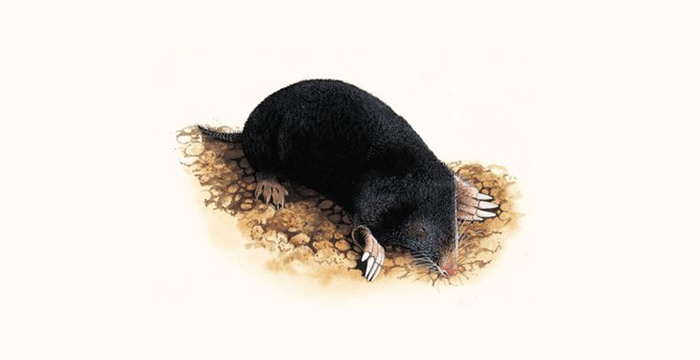
Mole
- Scientific name: Talpa europaea
- Type: Mammals
Key information
A mole looks very distinctive, if you can see one. It has a rounded body, velvety, grey-black fur, spade-like front claws, a short, furry tail, tiny eyes and a pink, pointed snout. They are found throughout mainland Britain, but not Ireland, wherever the soil is deep enough for tunnelling.
Moles are often considered pests by gardeners and farmers. They live underground, tunnelling up to 20m a day and leaving characteristic mounds of earth on the surface – molehills. They also dig out large chambers, which they line with dry grass for resting. Once made, mole tunnels are often used by several generations.
Moles are solitary creatures, except during the breeding season. After mating the female gives birth to a litter of up to five young during the summer.
What Do Moles Like To Eat?
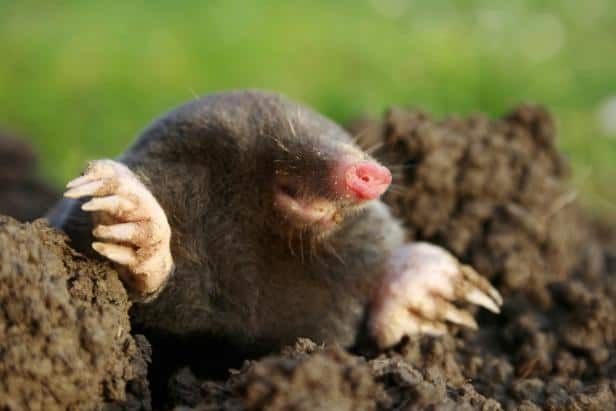
There are many pests that can invade your yard and damage your landscaping and lawn, but none do the job as perfectly as the mole.
There are many pests that can invade your yard and damage your landscaping and lawn, but none do the job as perfectly as the mole. Moles are insectivores, choosing to feed on mostly insects. They are commonly confused with rodents like mice and voles. Moles are generally around 6-8 inches long; they have soft brown to dark gray fur and long snouts that protrude about an inch. The most distinguishing feature of moles, however, is their oversized front feet that have paddle-shaped hands and large, sharp claws.
You are not likely to actually see moles since they spend most of their time underground only rarely making an above-ground appearance, but you are very likely going to notice the damages they leave in their wake. Annuals, lawns, and gardens are most often the victim of a mole infestation; but these are not their targets.
What Do Moles Eat?:
The damages done are not because moles are feeding on the grass and plants, but rather mole damages occur as they dig and forage for food. Their favorite meal includes earthworms, grubs, snails, spiders, small animals, and other insects. Because moles require a lot of food for energy, they eat more than their one-pound body weight in food each day. Moles will also consume around 60%-100% of their body weight in earthworms, grubs and insects every single day.
The most likely sign that you will notice when moles have infested are the mole mounds they create while tunneling under your lawn or garden to create nesting burrows and pathways to lead them to food sources. The mounds are only a few inches high, but this is a poor indicator of the actual damage below the surface. Even though the tunnels are created beneath the ground, over time, they will become visible above ground appearing as raised lines in your lawn. The tunnels that they use for feeding are often zigzagging and more shallow than the ones they dig to travel through. These tunnels damage the roots of the grass and plants above which eventually causes them to die. Feeding tunnels are used until the food source in that tunnel is exhausted, and then new tunnels will be created. The damages often become severe in a short amount of time.
If you are noticing the signs that moles leave behind, don’t wait for damages to become severe before you take a stand. Contact the pest professionals here at Rottler Pest & Lawn Solutions at the very first sign. Our wildlife control experts have the tools, technology, and training to humanely deal with a mole infestation, giving you back the control over your lawn and your garden. To learn more about our mole control service or any of our other industry-leading pest control solutions for your home or business, contact us today.
What Do Moles Eat – Overall
Although moles can be destructive, their tunneling can have a beneficial impact on the environment by providing a natural form of insect control and aerating the soil in the process.
No matter what, moles will constantly follow their food source leaving behind tunnels and mounds as they go.
If that food source just happens to be in your lawn or garden (chances are it is) your next step is to determine if you want to live with the moles…….or without them.
Trapping is by the far the fastest and most effective way to remove unwanted moles.
Mole traps are easy to set, and if you set them on an active mole run, you can typically trap one the same day you set your trap!
